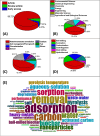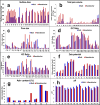Definitive Review of Nanobiochar
- PMID: 38524436
- PMCID: PMC10955718
- DOI: 10.1021/acsomega.3c07804
Definitive Review of Nanobiochar
Abstract
Nanobiochar is an advanced nanosized biochar with enhanced properties and wide applicability for a variety of modern-day applications. Nanobiochar can be developed easily from bulk biochar through top-down approaches including ball-milling, centrifugation, sonication, and hydrothermal synthesis. Nanobiochar can also be modified or engineered to obtain "engineered nanobiochar" or biochar nanocomposites with enhanced properties and applications. Nanobiochar provides many fold enhancements in surface area (0.4-97-times), pore size (0.1-5.3-times), total pore volume (0.5-48.5-times), and surface functionalities over bulk biochars. These enhancements have given increased contaminant sorption in both aqueous and soil media. Further, nanobiochar has also shown catalytic properties and applications in sensors, additive/fillers, targeted drug delivery, enzyme immobilization, polymer production, etc. The advantages and disadvantages of nanobiochar over bulk biochar are summarized herein, in detail. The processes and mechanisms involved in nanobiochar synthesis and contaminants sorption over nanobiochar are summarized. Finally, future directions and recommendations are suggested.
© 2024 The Authors. Published by American Chemical Society.
Conflict of interest statement
The authors declare no competing financial interest.
Figures
















References
-
- Mohan D.; Abhishek K.; Sarswat A.; Patel M.; Singh P.; Pittman C. U. Jr Biochar production and applications in soil fertility and carbon sequestration - a sustainable solution to crop-residue burning in India. RSC Adv. 2018, 8 (1), 508–520. 10.1039/C7RA10353K. - DOI
-
- Mohan D.; Pittman C. U. Jr.; Mlsna T. E.. Sustainable Biochar for Water and Wastewater Treatment; Elsevier Science, 2022.
-
- Patel M.; Chaubey A. K.; Navarathna C.; Mlsna T. E.; Pittman C. U.; Mohan D.. Chapter 11 - Sorptive removal of pharmaceuticals using sustainable biochars. In Sustainable Biochar for Water and Wastewater Treatment; Mohan D., Pittman C. U. Jr.; Mlsna T. E., Eds.; Elsevier, 2022; pp 395–427.
-
- Patel M.; Chaubey A. K.; Pittman C. U. Jr; Mohan D. Aqueous ibuprofen sorption by using activated walnut shell biochar: process optimization and cost estimation. Environmental Science: Advances 2022, 1 (4), 530–545. 10.1039/D2VA00015F. - DOI
Publication types
LinkOut - more resources
Full Text Sources
